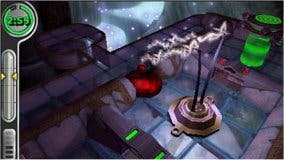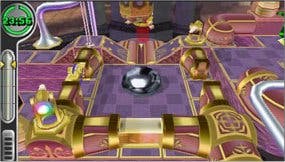Archer Maclean's Mercury
We test Awesome Studios' metal.
Interesting conversation. In the pub the other day (side note: for those questioning my continual pub references recently, I am actually spending a lot more time in the pub; it's not just the product of some editorial mandate to be blokish in print), a friend of mine who reads the site quite a lot asked me why I have such a problem with concept art. I'm "always taking shots at it", apparently. I suppose I am. What I said to him was simple: I like concept art; I just don't see it as a satisfactory reward for tirelessly chipping away at a game. If you like a game and you're good at it, it should be clever enough to reward you with things that accentuate and augment the things you love about it. To me, that's good reward structure. Spending an hour taking on the same task over and over in exchange for a scrawled version of the main character, which looks blurry on your TV anyway, doesn't seem as worthwhile. Half-Life 2 got this right - continually evolving, toying with your expectations, turning evil things on their head (or putting them on a virtual leash), and climaxing in a symphonious spectacle of mechanical rediscovery and oblique storytelling. Mercury also gets it right.
It's a very simple idea, executed about as well as it can be on the PSP. In brief, you are given responsibility for a gelatinous blob of liquid metal (mercury, obviously), which you can move around by tilting the maze-like level you're tackling with the analogue nub. The idea is to manoeuvre it to a finishing circle under certain conditions. It's a high scores game, primarily, and the design of the majority of the levels is inventive and layered enough that you can spend ages exploring the possibilities, trying new things, dismissing them, restarting, and then settling on one and bombarding the game with attempts until your plan comes to fruition. And, cleverly, it's layered up in a manner that continually rewards your persistence with new content that gives you more of what you're already enjoying.
Playing it soon becomes a joyous experience. The mercury is animated like one of those floating blobs of liquid metal from an old 3dfx tech demo, all jiggly and reflective, and the degree of inertia in changing direction is superbly measured to take into account various conditions (moving panels, slow panels, etc) as well as the size of the blob in question. It can be split, you see, into a number of smaller blobs either deliberately or, perhaps in your haste, accidentally, and each of these reacts to the tilting of the level to a degree consistent with its mass. This can be frustrating, but it's also the key to the game's success. But it'll be easier to explain that as I'm outlining the level structure.

Mercury is split into a number of worlds, each of which is split again (yes, this is already becoming something of a theme) into Race, Percentage, Task and Combo levels with a final Boss level that basically uses everything you've been fighting against up to that point in concert. Race levels are simply a quest to get to the end as fast as you can. You don't need all of your mercury to end up on the finishing circle, but you do need to make sure none of it has fallen off the side of the level somewhere if you want to maximise your score. In Percentage levels, however, time is irrelevant; it's all about getting a certain percentage of your mercury to the end, and these levels are understandably therefore a lot harsher on you in terms of obstacles and pitfalls. Task, to round off the distinct level types, is about operating a number of switches, often colour-coded, and regularly demands pinpoint control of multiple blobs of mercury. Combo and Boss levels, finally, combine all three disciplines, although Boss levels go further.
There are also various "ninja" levels to unlock by topping high score tables in each world, and these levels underscore the game's strengths in terms of physics and astute puzzle design to an even greater degree. Finally, there's a whole bonus world to unlock by topping out each of these levels, and it's a reflection of the fact Mercury comes over so well to the Monkey Ball aficionado inside me that I seriously considered putting off the review another day just to inch my way a little closer.
I've mentioned Monkey Ball, then. Comparisons to Super Monkey Ball are fair as long as you're talking more about the way you come at it than the way it actually handles. Both are high score games at heart, but through its mini-games and simpler premise SMB was always going to be better at attracting gamers with less of a mind to sit around playing one level for an hour without pause. In essence, Monkey Ball is a whole game, whereas Mercury is more of one big long endgame for the sort of people who can do the 0.1 wire on SMB's guitar strings level. Or, rather, who want to be able to. The monkeys in balls are all about speed and fine control; Mercury can be about that, but it splits things off more. Race is the closest of the three main level types, but it's more about reaching the finishing post with your outstretched index finger whilst lying sprawled across half the level. Percentage, meanwhile, strips out the speed factor, making for a "hit things or tip off the side and lose points" experience probably more consistent with Marble Madness's "hit things and lose time" than anything Amusement Vision did in Monkey Ball. Task, finally, isn't really directly comparable to either game. It's a bit like a sliding tile puzzle with two tiles on the go - move one and you inevitably reposition the other - but it also demands you consider percentages, time and be mindful of the respective weights of your blobs, given that smaller ones move fastest.

Mind you, Combo is actually a bit like Monkey Ball. At least, it's what Monkey Ball would be like if you had to control multiple monkeys in formation at varying speeds, juggling the need to hit multiple switches, avoid zappers and pursuing enemies, observe a time limit and, of course, take advantage of the very few guard rails you have at your disposal to avoid tumbling into the world of Game Over.
Level design in Mercury is often ingenious. As well as manoeuvring through mazes and not falling off things, there are switch gates (colour-coded in some cases), conveyor belts (including some that are meant to chuck you across the level), teleporters, ramps and jumps, beacons that require a certain amount of mercury to light, and all manner of obstacles and enemy structures, like little ball-shaped zapper bastards who chase you around, pillars that thump down and splash you everywhere, electric zappers, and a vast number of other things. It's continually inventive and varied, with the worlds binding together levels more in terms of level components than actual design. You can go from a level that involves managing multiple blobs of coloured mercury so that they pool together and form a third colour at the right point in your play-through, to a helter skelter level that involves navigating down a side-on maze of moving platforms and then using fast-moving conveyor belts to transfer between platforms on the way back up to the finish post at the top.
But it's the hidden depths that deserve the most praise. The level I just described is a perfect example. In order to beat the top score, it's necessary to cut corners, and it's fascinating to see just how much you can; this example involved using the increased friction that you get from pushing up close against a wall to squeeze around the size and fall onto a platform you'd only get to about three quarters of the way through the level if you played it in the obvious way. And that's not even the only shortcut; there are about four or five different things you can do to shave seconds off your time, and finding them is only one part of it; you also have to find a way to put your theories into practice whilst preserving as much mercury as humanly possible. Although some levels only flirt with this sort of shortcutting, there are a hell of a lot of things to consider away from the beaten track. Or the beaten thought process, rather.
But Mercury isn't for everyone, and its focus on making the most out of its ingenious premise - by allowing you to split the mercury up and take advantage of the physics to eke out the most ingenuity - has borne out a couple of issues that will, for some, derail the entire experience. First off: Mercury is for people who already like Mercury. If you're reading this page and you're enthralled by the idea of lateral thinking physics puzzles for the sometimes-inhumanly dextrous, then you are the game's target audience. But it hasn't really been designed for people who prefer to just play a game until it's over and then stop. The low-end game is actually pretty straightforward. There's been talk of difficulty spikes, but they're not really that; they're just the point at which the endgame can't help overlapping and you get a taste of what those of us playing the same level for an hour are really in it for.

The other issue is the camera, but to be fair it's difficult to imagine what else Awesome Studios could have done. It's just incredibly hard to frame multiple dynamic moving objects at all times on what is, however big it may seem next to its direct competitor, a pretty small screen. And, when faced with frustrations borne of the camera, the average gamer is probably going to say enough is enough. Those in my boat, however, could very well get over it. I did. Management of which blob you're focused can be a bit counterintuitive, but after a few minutes with a level you can usually work out where and when to muck about with the camera (using shoulder buttons to zoom, and face buttons to raise and lower or turn at 90-degree angles), and it almost becomes part of the strategy. A flaw, yes, but some flaws have to be viewed in the context of a much greater good. Like Kristan's spelling [I like to think of it as more of Jazz-English than a lack of attention to detail - Ed]
And so, the requisite review joke out of the way, we arrive at the most divisive point: the score. This one was always going to be difficult, because the game is very plainly targeted at a certain audience. Fortunately for me, I seem to be that target audience, and I can tolerate the camera issue, which is the only thing that bothers me. Bosh. 8. However, those of you envisaging something closer to Super Monkey Ball's melange of casual and hardcore physics-puzzle pursuits, with something for every occasion and house guest, may be left wanting.
That said, I'm certainly not ending this on a downbeat, so let's be plain: I've had more fun playing Mercury than any other PSP game so far. It is my new Zoo Keeper. That is all.

